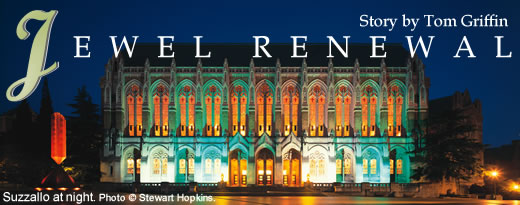
|
After a Decade of Planning and Construction, a $47-Million Price Tag and a 6.8 Earthquake, Suzzallo Library Returns to its Rightful Place as the Soul of the University. In 1915 it is a dot on a new campus plan that makes it the center of campus. In 1923 it is a series of working drawings by the head of the architecture department. It later shows up on his family's Christmas card, including the design for a 260-foot tower that is never built. In 1926 it is one of the "extravagances" that causes the governor to pack the Board of Regents and fire the UW president. In 1927 it opens to great acclaim—the reading room "is pronounced by experts to be the most beautiful on the continent and is ranked among the most beautiful in the world."
In 1933 it is named after the same president who was fired a few years earlier. In 1935 a south wing opens following the architect's plan. In 1963 the University discards the original design for a modernist addition by Bindon and Wright. By this point in time, much of the original reading room furniture is "surplused." In 1991 it is designated one of the most dangerous buildings on campus during an earthquake. "It" is Suzzallo Library, the "soul of the University," according to President Henry Suzzallo and "the dominant feature, not only of the library for all time, but of the University as a whole," according to its architect, Carl Gould, the first chair of the UW architecture department.
Technically a collection of wings and additions, most alumni think of the western side of Suzzallo when someone mentions the UW's main library. Built in 1927, it is the campus cathedral—a soaring exterior of 11 monumental stained glass windows, framed by Gothic-inspired statues, arches and buttresses made of terra cotta, cast stone and brick. Inside is the most voluminous library reading room in the nation—65 feet high, 52 feet wide and 250 feet long—a sanctuary for learning. Gould's biographers say it is one of his finest works. One architecture historian calls it the "acme" of Collegiate Gothic at the UW. For the hundreds of thousands of alumni who once studied there, it is a treasured place where they sought inspiration to learn—and, for some, a quiet place to sleep (See "Suzzallo Memories"). But behind the beauty lurked danger. Because it came together in bits and pieces (besides the 1927 wing, there were additions built in 1935, 1947 and 1963), Suzzallo was a structural disaster in the making. In an earthquake, these wings could move at different speeds, the walls of each section banging against the other. Add to the structural danger thousands of people walking in and out of the library every day, and you have "high damage potential" and "high life safety danger," said a 1991 report on the seismic status of campus buildings. Engineers ranked it and Hec Edmundson Pavilion as the most dangerous campus buildings in an earthquake. Go To: Page 1 | Page 2 | Page 3
|
||||||||||||||





